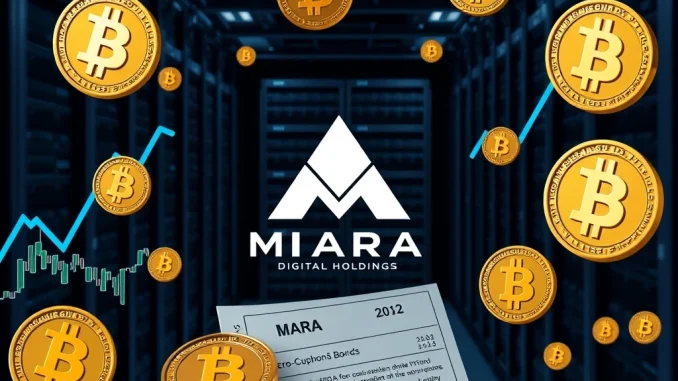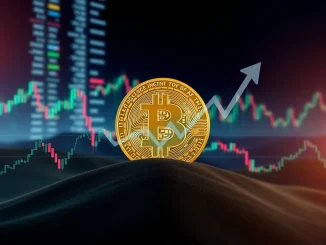
In a significant move that has sent ripples across the cryptocurrency and traditional financial markets, Marathon Digital Holdings (Nasdaq: MARA), one of North America’s largest Bitcoin mining companies, has announced a monumental financial maneuver. The firm is issuing $850 million in zero-coupon convertible senior notes due 2032, primarily to fuel an aggressive Bitcoin acquisition strategy and strategically refinance existing debt. This ambitious decision, while aiming to bolster MARA’s digital asset reserves, was met with a cautious market response, leading to a 4.5% dip in MARA stock immediately following the news. What does this mean for the future of crypto investment and corporate finance in the digital age?
MARA’s Ambitious Bitcoin Acquisition Drive
Marathon Digital Holdings is making a bold play to solidify its position as a major holder of Bitcoin. The core of their latest announcement revolves around a private offering of $850 million in zero-coupon convertible senior notes. This substantial capital raise is earmarked for two primary objectives:
- Bitcoin Purchases: Approximately $800 million of the proceeds will be channeled directly into acquiring more Bitcoin, significantly expanding MARA’s corporate treasury holdings. This underscores the company’s long-term conviction in Bitcoin’s value as a strategic asset.
- Debt Refinancing: A smaller portion, around $50 million, is designated to repurchase existing 1.00% convertible notes due 2026. This move aims to reduce short-term debt obligations, providing greater financial flexibility.
Adding another layer to this strategic funding, the initial purchasers of these notes have an option to acquire an additional $150 million, potentially increasing the total capital raised to $1 billion. This optionality provides MARA with further flexibility to scale its Bitcoin acquisition efforts, contingent on market conditions and strategic needs. The company has consistently emphasized its view of Bitcoin holdings as crucial corporate treasury assets, a strategy that aligns with broader trends of institutional adoption in the crypto space.
Understanding Zero-Coupon Convertible Notes and Capped Calls
The financial instrument at the heart of MARA’s latest funding round is the zero-coupon convertible senior note. To fully grasp the implications of this offering, it’s essential to break down its components:
- Zero-Coupon: Unlike traditional bonds, these notes do not pay regular interest. Instead, they are typically issued at a discount to their face value, and investors receive the full face value (or its equivalent in cash/shares) upon maturity. This structure means MARA avoids periodic cash outflows for interest payments, conserving capital for its operational and investment goals.
- Convertible Senior Notes: These are a type of unsecured debt that can be converted into a specified number of the issuer’s shares (in this case, MARA shares), cash, or a combination of both, under certain conditions. The conversion rate usually depends on the issuer’s share price performance relative to a pre-defined conversion price. For MARA, these notes mature in August 2032.
- Capped Call Transactions: To mitigate potential shareholder dilution from future conversions, MARA has simultaneously entered into capped call transactions. These are derivative instruments designed to limit the number of shares issued if the notes are converted into equity. Essentially, they act as a ceiling on the effective conversion price, providing a degree of protection for existing shareholders against excessive dilution while allowing the company to raise capital efficiently.
This sophisticated financial engineering allows MARA to raise a significant amount of capital without immediate interest payments, while also addressing concerns about future equity dilution. It’s a strategic choice reflecting a nuanced approach to leveraging debt for aggressive growth within the volatile crypto market.
Market Reaction: Why Did MARA Stock Dip?
Despite the strategic benefits of securing substantial capital for Bitcoin acquisition and debt refinancing, the market’s initial reaction to MARA’s announcement was notably negative. MARA stock experienced a 4.5% decline, reflecting investor apprehension. Several factors likely contributed to this cautious sentiment:
- Increased Leverage: Issuing $850 million (potentially $1 billion) in new debt significantly increases MARA’s financial leverage. While the notes are zero-coupon, the principal amount still needs to be repaid or converted, adding to the company’s overall debt burden. In a capital-intensive industry like Bitcoin mining, high leverage can amplify risks, especially during periods of market volatility.
- Perceived Dilution Risk: Although the capped call structure is designed to limit dilution, the possibility of future share issuance upon conversion remains a concern for investors. The exact conversion rate depends on MARA’s future share price, introducing uncertainty. Investors often react negatively to any news that suggests potential dilution of their existing equity holdings.
- Sustainability in Volatile Markets: The reliance on convertible debt to fund speculative asset purchases (Bitcoin) raises questions about long-term sustainability, particularly if Bitcoin’s price trajectory does not align with MARA’s expectations. While MARA has a strong conviction in Bitcoin, the crypto market is inherently volatile, adding a layer of risk to debt-funded acquisitions.
This market reaction underscores the ongoing debate among investors regarding the balance between aggressive growth ambitions and prudent risk management in the rapidly evolving digital asset space. While some see MARA’s move as a visionary step, others view it with caution due to the inherent risks of high leverage in a speculative market.
Navigating the Future: MARA’s Crypto Investment Strategy
MARA’s decision to leverage convertible notes for substantial Bitcoin accumulation highlights its conviction in the long-term value proposition of the digital asset. This strategy positions the company not just as a miner, but also as a significant holder of Bitcoin, aligning with broader institutional trends. However, the success of this ambitious crypto investment strategy hinges on several critical factors:
- Bitcoin Price Trajectory: The profitability and strategic soundness of acquiring large amounts of Bitcoin are inextricably linked to its future price performance. A sustained bull market would validate MARA’s strategy, while a prolonged downturn could exacerbate the risks associated with increased leverage.
- Operational Efficiency: Beyond Bitcoin acquisition, MARA’s core business remains Bitcoin mining. The company’s ability to maintain and improve operational efficiency, manage energy costs, and expand its mining infrastructure will be crucial for generating the cash flow needed to support its financial obligations and capitalize on its Bitcoin holdings.
- Integration and Treasury Management: Effectively integrating these new Bitcoin acquisitions into its corporate treasury strategy, while maintaining financial flexibility, will be a key challenge. Robust risk management frameworks will be essential to navigate market fluctuations.
This strategic focus on Bitcoin accumulation, funded by innovative debt instruments, is a testament to the evolving landscape of corporate finance in the digital asset sector. As a leading Bitcoin mining company, MARA is setting a precedent, and its journey will be closely watched by investors and industry participants alike.
Conclusion: A Bold Gamble or a Strategic Masterstroke?
Marathon Digital Holdings’ $850 million offering of zero-coupon convertible senior notes represents a significant and decisive step in its corporate strategy. By allocating the vast majority of these funds to Bitcoin acquisition and simultaneously refinancing existing debt, MARA is doubling down on its conviction in Bitcoin as a long-term treasury asset. While the innovative use of convertible notes and capped call structures demonstrates financial sophistication, the immediate negative reaction in MARA stock underscores the market’s concerns regarding increased leverage and potential dilution risks.
This move is a clear indicator of MARA’s aggressive pursuit of growth and its unwavering belief in the future of Bitcoin. As the company navigates the complexities of debt financing in a volatile market, its ability to execute its crypto investment strategy, manage operational efficiencies, and adapt to the ever-changing digital asset landscape will be paramount. The coming months will reveal whether this bold gamble pays off, cementing MARA’s position as a dominant force in the Bitcoin ecosystem, or if the inherent risks of high leverage in speculative markets prove to be a formidable challenge.
Frequently Asked Questions (FAQs)
Q1: What are zero-coupon convertible senior notes?
Zero-coupon convertible senior notes are a type of unsecured debt that pays no regular interest. Instead, they are typically issued at a discount and can be converted into the issuer’s stock, cash, or a combination of both under specific conditions, usually based on the company’s share price performance. They offer flexibility by deferring interest payments and providing an equity upside for investors.
Q2: Why did MARA issue these notes primarily to buy Bitcoin?
MARA issued these notes to significantly expand its Bitcoin holdings, viewing Bitcoin as a strategic, long-term corporate treasury asset. This move aligns with its strategy to leverage its position as a leading Bitcoin mining company and benefit from potential appreciation in Bitcoin’s value.
Q3: How do capped call transactions protect MARA shareholders?
Capped call transactions are derivative agreements that limit the number of shares MARA would have to issue if the convertible notes are converted into equity. They effectively cap the conversion price, reducing the potential dilution for existing shareholders by setting an upper limit on the number of shares that can be issued upon conversion.
Q4: Why did MARA’s stock price drop after the announcement?
MARA’s stock price dropped due to investor concerns over increased financial leverage from the new debt and the potential for future shareholder dilution, despite the mitigating effect of capped call transactions. The market also reacted to the perceived risk of using debt to fund large-scale acquisitions of a volatile asset like Bitcoin.
Q5: What are the main risks associated with MARA’s new financing strategy?
The main risks include increased financial leverage, which amplifies sensitivity to Bitcoin price fluctuations; potential dilution if the notes convert into shares (even with capped calls); and the inherent volatility of the crypto market, which could impact the value of the acquired Bitcoin and MARA’s ability to service its obligations.
Q6: What does this move signify for the broader crypto industry?
MARA’s large-scale debt-funded Bitcoin acquisition highlights a growing trend of institutional adoption and sophisticated financial strategies being employed by crypto-native companies. It signifies a continued belief in Bitcoin’s long-term value as a corporate asset and demonstrates how companies are exploring innovative financing methods to expand their digital asset reserves.



